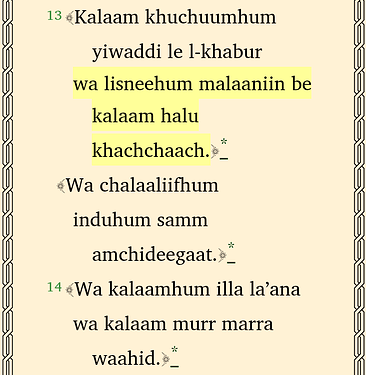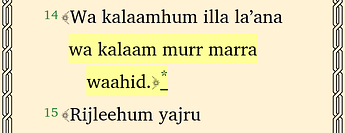If you download my test app above and check out the problem at Rooma (ROM) 3:13, this is what the text looks like:
If you play the audio, it reads fine until you get to the end of that first \q1 \q2 (the middle of the verse). The highlighting of that \q2 is as shown in the image above. It does not select the fancy bracket or the footnote marker. Then when it starts to read the next segment (Wa chalaaliifhum), it highlights the fancy bracket and the footnote marker (considering it the next segment, apparently). And when it starts reading “induhum samm…” it highlights the \q1 before it (Wa chalaaliifhum).
So it seems like the problem is that it is considering the fancy bracket + footnote marker as a separate segment, at least when the verse continues after that. The fancy bracket + footnote marker at the end of that verse gets highlighted with the text just fine when it is read:
But it is also at the end of the verse, a context which doesn’t seem to show this problem.
I thought someone might like to see the output when I export that chapter to HTML, so here it is, from the end of v.12 to the beginning of v.15:
<div class="q2"><div id="T12c" class="txs">wa la waahid.<span class="op">﴿</span><span class="footnote selectable" id="F-1"><sup>*</sup></span></div><span id="bookmarks12"></span></div><span id="bookmarks12"></span><a id="v13"></a>
<div class="q-vv"><div id="T13a" class="txs"><span class="v">13</span><span class="vsp"> </span><span class="op">﴾</span>Kalaam khuchuumhum yiwaddi le l‑khabur</div></div>
<div class="q2"><div id="T13b" class="txs">wa lisneehum malaaniin be kalaam halu khachchaach.</div><div id="T13c" class="txs"><span class="op">﴿</span><span class="footnote selectable" id="F-2"><sup>*</sup></span></div></div>
<div class="q"><div id="T13d" class="txs"><span class="op">﴾</span>Wa chalaaliifhum</div></div>
<div class="q2">induhum samm amchideegaat.<span class="op">﴿</span><span class="footnote selectable" id="F-3"><sup>*</sup></span><span id="bookmarks13"></span></div><span id="bookmarks13"></span><a id="v14"></a>
<div class="q-vv"><div id="T14a" class="txs"><span class="v">14</span><span class="vsp"> </span><span class="op">﴾</span>Wa kalaamhum illa laʼana</div></div>
<div class="q2"><div id="T14b" class="txs">wa kalaam murr marra waahid.<span class="op">﴿</span><span class="footnote selectable" id="F-4"><sup>*</sup></span></div><span id="bookmarks14"></span></div><span id="bookmarks14"></span><a id="v15"></a>
<div class="q-vv"><div id="T15a" class="txs"><span class="v">15</span><span class="vsp"> </span><span class="op">﴾</span>Rijleehum yajru</div></div>
You can see that the \q2 in the middle is broken into two <div class="txs"> elements, but the \q2 at the end is just one div. It’s easier to see if I tidy up the XML in those two spots:
<div class="q2">
<div id="T13b" class="txs">wa lisneehum malaaniin be kalaam halu
khachchaach.</div>
<div id="T13c" class="txs">
<span class="op">﴿</span>
<span class="footnote selectable" id="F-2">
<sup>*</sup>
</span>
</div>
</div>
<div class="q2">induhum samm amchideegaat.
<span class="op">﴿</span>
<span class="footnote selectable" id="F-3">
<sup>*</sup>
</span>
<span id="bookmarks13"></span></div>
Note that the second div doesn’t even have the class="txs", which seems to be the text section designation. At the end of verse 12 (which does highlight the fancy bracket and the footnote marker correctly), you can see that the div that covers the text of that \q2 and the fancy bracket and the footnote marker DOES include the class="txs".
So how can we get that fancy bracket and footnote marker to get included in that earlier <div class="txs">? (Which would then push the <div id="T13c" class="txs"> down to the “We chalaaliifhum” text, and push the <div id="T13d" class="txs"> down to the “induhum samm” text, where it should be.)

